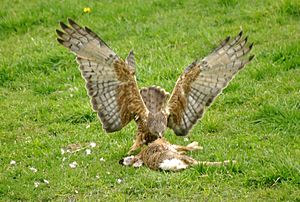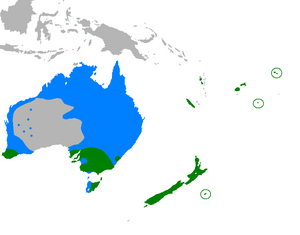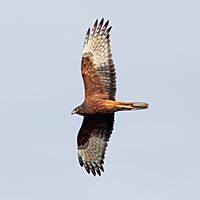Swamp harrier facts for kids
The swamp harrier (Circus approximans) is a large, slim bird of prey. It is found across Australasia, which includes Australia and New Zealand. In New Zealand, people also call it the harrier hawk or by its Māori name, kāhu. This bird arrived in New Zealand only about 700 years ago. It took the place of a larger, now extinct, harrier species that used to live there.
Swamp harriers belong to a group of birds called Circus. This group is found all over the world, except in Antarctica. These birds are known for flying in circles when they are looking for a mate or hunting.
Quick facts for kids Swamp harrier |
|
|---|---|
 |
|
| Adult female swamp harrier with a hare | |
| Conservation status | |
| Scientific classification | |
| Genus: |
Circus
|
| Species: |
approximans
|
 |
|
Contents
What Does the Swamp Harrier Look Like?
The swamp harrier is mostly dark brown. It gets lighter in color as it gets older. It has a clear white patch on its lower back, called a rump.
This bird hunts by flying slowly and low to the ground. Its wings are held in an upswept V-shape. The swamp harrier is about 48 to 62 centimeters (19 to 24 inches) long. Its wings can spread out from 118 to 145 centimeters (3 feet 10 inches to 4 feet 9 inches) wide.
Adult swamp harriers usually weigh between 580 and 1,100 grams (1.3 to 2.4 pounds). Female harriers are much bigger than males. In New Zealand, male harriers weigh about 640 grams (1.4 pounds). Females weigh about 870 grams (1.9 pounds). The swamp harrier might be the largest type of harrier bird alive today.
Where Do Swamp Harriers Live?
Swamp harriers live across Australasia and many islands in the southwest Pacific. This includes most of Australia, except for very dry areas. They are also common in New Zealand. You can find them in Fiji, Vanuatu, and New Caledonia. Sometimes, they even fly to some islands near Antarctica.
These birds usually live in wetlands and open areas with plenty of water.
The harrier only came to New Zealand a few hundred years ago. This happened after the first Polynesian settlers cleared many lowland forests. There is no sign of them in older animal records. They have also done well since European settlers arrived. Now, they are very common, especially on open farmland.
How Do Swamp Harriers Behave?
Some common enemies of harriers include Australian magpies and masked lapwings. These birds will fly down and attack harriers. European starlings also gather in groups to bother them.
Swamp harriers have been known to kill young kārearea. People have also blamed them for killing chickens, pheasants, and ducklings.
In New Zealand, swamp harriers are the only birds of prey used for falconry. Falconry is a sport where people hunt with trained birds. The harriers usually hunt pukeko (a type of swamp hen) and young rabbits.
What Do Swamp Harriers Eat?
The swamp harrier mostly eats ground birds and waterbirds. They also hunt rabbits and other small mammals. Their diet includes reptiles, frogs, and fish.
In winter, harriers eat a lot of dead animals, called carrion. This includes animals killed on roads. Sadly, harriers themselves often get hit by cars while eating roadkill.
Swamp Harrier Reproduction
This bird builds its nest on the ground. Nests are often found in swamps, on a small mound in reeds, or in thick plants. In some places, they build nests in fields of oats or barley.
A female harrier usually lays three or four eggs, but sometimes two to seven. The female sits on the eggs for 31 to 34 days to keep them warm. This is called incubation. Both parents feed the baby birds, called chicks. The chicks grow all their feathers by 28 days old. They are ready to fly, or fledge, about 45 days after hatching.
See also
 In Spanish: Aguilucho lagunero del Pacífico para niños
In Spanish: Aguilucho lagunero del Pacífico para niños




